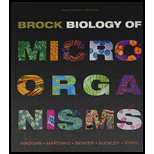
Brock Biology of Microorganisms, MasteringMicrobiology with eText and Access Card (14th Edition)
14th Edition
ISBN: 9780133857276
Author: Michael Madigan
Publisher: PEARSON
expand_more
expand_more
format_list_bulleted
Concept explainers
Question
Chapter 17, Problem 11RQ
Summary Introduction
Reproduction process in
Sexual spores are developed by the process known as fusion, in which two gametes of opposite sex are fused to form sexual spore. The cell which bears the gamete is known as gametangium. In sexual spore, meiosis takes place.
Conidia are produced on special hyphae called conidiophores and help in the germination of new fungal cells.
Expert Solution & Answer
Want to see the full answer?
Check out a sample textbook solution
Students have asked these similar questions
Some fungi can be viewed as coenocytic organisms that exhibit little differentiation. When differentiation does occur, such as in the formation of reproductive structures, it is preceded by septum formation. Why does this occur?
A. Differentiate the three classification of fungi.
B. How do fungi differ from bacteria and other eukaryotic organism?
C. Explain the point of difference between the sexual and asexual cycle of fungi.
List the different types of sexual spores of fungi. Areconidia sexual or asexual spores?
Chapter 17 Solutions
Brock Biology of Microorganisms, MasteringMicrobiology with eText and Access Card (14th Edition)
Ch. 17.1 - Prob. 1MQCh. 17.1 - Prob. 2MQCh. 17.1 - Prob. 3MQCh. 17.2 - Prob. 1MQCh. 17.2 - Prob. 2MQCh. 17.2 - Prob. 3MQCh. 17.3 - Prob. 1MQCh. 17.3 - Prob. 2MQCh. 17.4 - Contrast the two nutritional options for Euglena.Ch. 17.4 - Prob. 2MQ
Ch. 17.4 - Prob. 3MQCh. 17.5 - Prob. 1MQCh. 17.5 - Prob. 2MQCh. 17.5 - What are apicoplasts, which organisms have them,...Ch. 17.6 - Prob. 1MQCh. 17.6 - Prob. 2MQCh. 17.6 - Prob. 3MQCh. 17.7 - Prob. 1MQCh. 17.7 - How are chlorarachniophytes thought to have...Ch. 17.8 - Prob. 1MQCh. 17.8 - Compare and contrast the lifestyles of gymnamoebas...Ch. 17.8 - Prob. 3MQCh. 17.9 - What are conidia? How does a conidium differ from...Ch. 17.9 - Prob. 2MQCh. 17.9 - Prob. 3MQCh. 17.10 - Why is the mold Penicillium economically...Ch. 17.10 - Prob. 2MQCh. 17.10 - Prob. 3MQCh. 17.11 - Prob. 1MQCh. 17.11 - Prob. 2MQCh. 17.11 - Prob. 3MQCh. 17.12 - Prob. 1MQCh. 17.12 - Prob. 2MQCh. 17.12 - Prob. 3MQCh. 17.13 - Prob. 1MQCh. 17.13 - Prob. 2MQCh. 17.14 - Prob. 1MQCh. 17.14 - Prob. 2MQCh. 17.15 - What traits link cyanobacteria and red algae?Ch. 17.15 - Prob. 2MQCh. 17.16 - What phototrophic properties link green algae and...Ch. 17.16 - What is unusual about the green algae...Ch. 17.16 - Prob. 3MQCh. 17 - Prob. 1RQCh. 17 - Prob. 2RQCh. 17 - Prob. 3RQCh. 17 - Prob. 4RQCh. 17 - Prob. 5RQCh. 17 - Three groups make up the alveolates: ciliates,...Ch. 17 - Prob. 7RQCh. 17 - REVIEW QUESTIONS
8. What morphological trait...Ch. 17 - Prob. 9RQCh. 17 - Prob. 10RQCh. 17 - Prob. 11RQCh. 17 - Prob. 12RQCh. 17 - Prob. 13RQCh. 17 - Prob. 14RQCh. 17 - Prob. 15RQCh. 17 - Prob. 16RQCh. 17 - Green algae are common in aquatic environments and...Ch. 17 - Explain why the process of endosymbiosis can be...Ch. 17 - Summarize the evidence for endosymbiosis. How...
Knowledge Booster
Learn more about
Need a deep-dive on the concept behind this application? Look no further. Learn more about this topic, biology and related others by exploring similar questions and additional content below.Similar questions
- The life cycle of most fungi is best described by which of the following statements? A Fungi are unique and have different mechanisms of reproduction B Fungi only reproduce sexually C Fungi have both sexual and asexual portions of their life cycle D Fungi only reproduce asexually E None of thesearrow_forwardlist 3 differences in structure in bacterial and fungal cells. how do fungal spores differ from bacterial endospores?arrow_forwardHow can fungi be defined? What is the difference between a yeast and a mold?arrow_forward
- Fungi tend to reproduce sexually when nutrients are limited or other conditions are unfavorable, but they reproduce asexually in more ideal conditions. Why is this strategy successful? Please add a reference website, and an example if possiblearrow_forwardExplain the generalized life cycle of Fungi. need to include the following terms appropriately: Mycelium, haploid, diploid, karyogamy, spores, zygote, mitosis and meiosis, and germination.arrow_forwarddescribe the six main taxonomic groups of fungi and explain why some fungal species are not assigned to any of these groups?arrow_forward
- Describe two ways in which fungal spores arise. Sexual spores= zygosporesarrow_forwardFungi were once classified in the same kingdom as plants. Which characteristic of fungi resulted in them being placed in a separate kingdom?arrow_forwardCompare and contrast the following types of asexual fungal spores: sporangiospore, arthrospore, conidiospore, and blastospore.arrow_forward
- While working in a plant disease diagnostic lab, you receive a sample of a very dead tomato plant. The plant has rotted roots and the symptoms match known fungal and oomycete diseases of tomatoes. Explain one difference between true fungi and oomycetes that you could observe to determine what type of organism is killing the tomatoes?arrow_forwardIn what ways (both positive and negative) are fungi important in modern biology and medicine?arrow_forward
arrow_back_ios
arrow_forward_ios
Recommended textbooks for you
 Biology Today and Tomorrow without Physiology (Mi...BiologyISBN:9781305117396Author:Cecie Starr, Christine Evers, Lisa StarrPublisher:Cengage Learning
Biology Today and Tomorrow without Physiology (Mi...BiologyISBN:9781305117396Author:Cecie Starr, Christine Evers, Lisa StarrPublisher:Cengage Learning Biology: The Dynamic Science (MindTap Course List)BiologyISBN:9781305389892Author:Peter J. Russell, Paul E. Hertz, Beverly McMillanPublisher:Cengage Learning
Biology: The Dynamic Science (MindTap Course List)BiologyISBN:9781305389892Author:Peter J. Russell, Paul E. Hertz, Beverly McMillanPublisher:Cengage Learning Biology (MindTap Course List)BiologyISBN:9781337392938Author:Eldra Solomon, Charles Martin, Diana W. Martin, Linda R. BergPublisher:Cengage Learning
Biology (MindTap Course List)BiologyISBN:9781337392938Author:Eldra Solomon, Charles Martin, Diana W. Martin, Linda R. BergPublisher:Cengage Learning

Biology Today and Tomorrow without Physiology (Mi...
Biology
ISBN:9781305117396
Author:Cecie Starr, Christine Evers, Lisa Starr
Publisher:Cengage Learning

Biology: The Dynamic Science (MindTap Course List)
Biology
ISBN:9781305389892
Author:Peter J. Russell, Paul E. Hertz, Beverly McMillan
Publisher:Cengage Learning

Biology (MindTap Course List)
Biology
ISBN:9781337392938
Author:Eldra Solomon, Charles Martin, Diana W. Martin, Linda R. Berg
Publisher:Cengage Learning